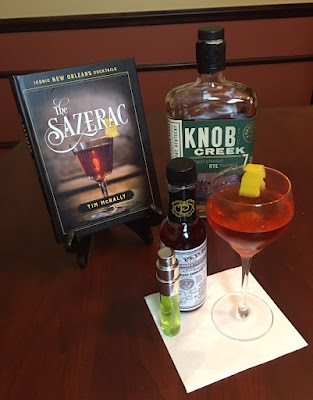The Sazerac
Things that remind you irresistibly of New Orleans: Red Beans and Rice, bare breasts and beads, and memories of running for your life on Canal Street after midnight.
Also the Sazerac, the emblematic cocktail of the Big Easy.
1 cube sugar
1.5 oz. Sazerac Rye Whiskey
0.25 oz. Herbsaint
3 dashes Peychaud’s Bitters
Lemon peel
The recipe involves two Old-Fashioned glasses (8-11 ounces volume). Chill the first one—that’s the one in which the completed Sazerac is going to end up. Then place the sugar cube and Peychaud’s bitters in the second. Muddle it to crush the sugar. (Personally, I use simple syrup. It’s quicker and does a more thorough job of mixing the sugar and bitters.) Add the Sazerac Rye Whiskey (actually, any good rye whiskey does just fine—there’s nothing special about the Sazerac Rye Whiskey except the name).
Empty the chilled glass and add the Herbsaint—if you have any, which you probably won’t. It doesn’t matter. Herbsaint is essentially absinthe, which is a lot more readily available. Or you can go with Pernod. The operative point is that you want an anise-flavored liqueur.
Swirl the Herbsaint (or whatever) to coat the glass, then discard the remainder. You can also do as I do and use a bar atomizer, which has the advantage of coating the glass evenly without having to waste any liqueur. It’s not as flashy as the way they do it at the Sazerac bar, which is to toss it in the air, spinning, but they still have to discard the remainder. Either way, you’ll end up being able to scent the anise. That’s an important part of the experience, although there should never be enough to affect the taste.
Empty the whiskey-bitters-sugar mixture from the first glass and pour it into the second. And there you have it. The drink should be very cold but without ice.
It’s easy to substitute the whiskey and Herbsaint without affecting the taste of the Sazerac. However, you *must* use Peychaud’s Bitters. It has a distinctive flavor from Angostura bitters or any other kind, as well as a distinctive red color.
Bitters are basically a combination of some sort of root or bark, a spirit, and a flavoring ingredient. For example: cinchona bark, bourbon, and apple. (This recipe is from Brad Thomas Parsons’ _Bitters: A Spirited History of a Classic Cure-All_ [Berkeley, CA: Ten Speed Press, n.d.]) Making bitters is a little more elaborate than this, but you get the idea.
Bitters originated as a patent medicine, which explains why the inventor, Antoine Peychaud, was a pharmacist. He came up with it in 1837. The recipe was and remains a proprietary secret.
Peychaud’s bitters probably didn’t do much for one’s health, but it worked just fine in a cocktail, and in the mid-1850s it became associated with the original Sazerac, which was precisely like the modern Sazerac except that it specifically called for absinthe and—more importantly—used Cognac rather than whiskey.
Cognac is a fortified wine and between the 1880s and 1900, French vineyards were ravaged by Phylloxera, small lice that prey upon the roots and tendrils of grapevines. As a result, the availability of Cognac dropped precipitously, necessitating a substitute. Which turned out to be rye whiskey. Which turned out to be just fine.
The Original Sazerac recipe is just like the modern version except that, of course, it explicitly calls for absinthe and Cognac. I’ve tried it both ways and prefer the original.




Comments
Post a Comment